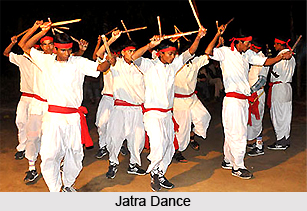 The Jatra dance in Bihar is one of the chief dance forms of the significant tribal population of the state. It is one of the major dance forms of the substantial tribal population of the Bihar state of India. It depicts the mock fights between people of one village with the other. The two groups representing each village advance for a combat with long poles surmounted by pennants and waving sticks and clubs. Jatras are particularly popular among the Oraons.
The Jatra dance in Bihar is one of the chief dance forms of the significant tribal population of the state. It is one of the major dance forms of the substantial tribal population of the Bihar state of India. It depicts the mock fights between people of one village with the other. The two groups representing each village advance for a combat with long poles surmounted by pennants and waving sticks and clubs. Jatras are particularly popular among the Oraons.
History of Jatra Dance
In the hilly districts of North of Bihar reside people who are akin to the Nepalese. Even their culture, language, and physical types resemble the Nepalese. Here the various forms of dances are of chiefly pastoral or warlike kind.
A tribe named as Tharus is inhabited in the foothill regions of Bihar. They were earlier driven out of Nepal hence they took shelter here. The Tharus are of short-stature Mongoloid people who are engaged in the work of hunting. Jatra dance is performed by this group of people.
Performance of Jatra Dance
In Jatra dance, two groups of dancers take part and perform a mock fight. Here, the dancers pretend to be fighting with each other. The dancers of both the groups carry poles in their hands. The dance is choreographed in such a way that it looks as if they are confronting each other. The dancers keep waving their hands holding these sticks and keep moving forward and backward, as the dance progresses. This dance consists of fast and rigorous steps. It has many steps where the actors enact the hunting of animals hence it can also be rightfully called the hunting dance of the tribals.
The songs are sung by a man in Nepalese languages who does not take part in the actual dance. His sole responsibility is singing and setting the tone for the dancers. The dances are accompanied by songs and various instruments like a dholak or a large drum.



















